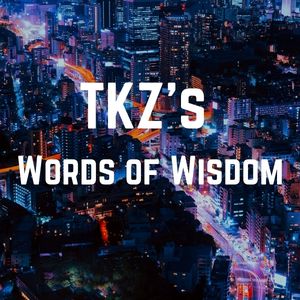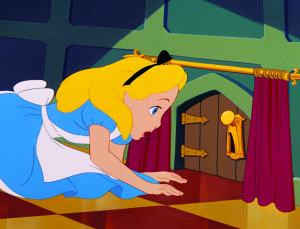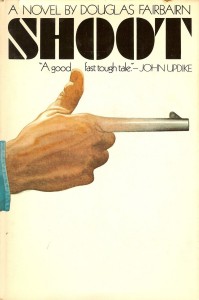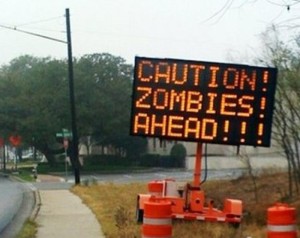Jordan Dane
@JordanDane

For your reading enjoyment, we have the first 400 words of an anonymous author’s work in progress. I’ll have my feedback on the flip side. Please provide your constructive criticism in your comments.
***
Dad and I arrived at Houston’s Medical Hospital as an orangy-pink sun dipped below the horizon. We hurried across a parking lot the size of a football field, the October breeze lifting wisps of my ash brown hair as we headed for the warmth of the building.
In the elevator, Dad punched the button for the third floor while I rubbed my hands together. We began our ascent with a jerk that made me latch onto Dad’s arm, and then I felt my stomach drop. Just what I needed.
We greeted Mr. and Mrs. Garrett in the visitor’s waiting room. After catching up on the latest news regarding Slate’s condition, I walked alone to Room 316. Rounding the nurses’ station, a concoction of hospital smells assaulted my nostrils: alcohol, chlorine, undefinable cafeteria food, and floor wax. Lovely. I leaned against the wall for a few moments, my hand on my empty and now queasy stomach, before continuing down the hall.
Finding the door to Slate’s room closed, I took a moment to smooth my hair, powder a shiny nose, remove an errant eyelash threatening to slide under my blue contact lens. Then I knocked.
“Yeah.”
I peeked in. “Hi.”
Slate Garrett sat propped up in bed, two pillows behind his back. His velvet brown eyes were dark. “Did you hear?”
I nodded and walked towards him. Lindell High’s all-state linebacker would’ve looked ridiculous in his pale hospital gown under other circumstances; but his blackened left eye, busted lip, and the white bandage behind his left ear took all humor out of the situation.
“Three games into my senior year, and this has to happen. Benched for the rest of the season. No college scholarship, no playing for the Longhorns, no more football. Ever!”
I could almost hear his heart breaking. I blinked back tears.
His own eyes watering, Slate reached for the glass on his nightstand and drank from it.
I feigned interest in his room while we both tried to regain self-control. His gold wristwatch and an opened package of malted milk balls lay on the nightstand beside his bed. A chair stood in the corner, a football resting on its cushion.
I walked over and touched the stiff, stained laces. “What’s this doing here?”
“Game ball from Friday night. Like I want it now.”
FEEDBACK
OVERVIEW – Depending on what genre this novel will be, the opening could start earlier with the injury on the field and more action. Or it could start with the young woman narrator rushing to the hospital, leaving the reader to wonder what is happening and who will be there. I prefer more action than the way this story starts so the reader is drawn into the novel by elements of mystery and the emotions of something about to happen. Even in the case of a romance, mystery elements still have their place. Readers want to be sucked into a story with anticipation of what will happen. This particular story reads like a romance or maybe a Young Adult (YA)/New Adult with younger characters that could grow into their early twenties. Who doesn’t love a good sports story with the struggles of a romance mingled between the lines? Sign me up, but let’s take a look at where to begin.
Genre & Elements of Romance – If this is a romance or YA, don’t rush a scene between a girl and a boy. Add layers to their relationship. The sexual tension, even if it’s only one way, can pull a reader in.
Be sensitive to eye contact or touches or the hyper awareness of the girl who has feelings for a guy who may not notice her. Does she see his skin flushing with color? Does she have heat rising to her cheeks? Pay attention to the details and only put in enough to not slow the pace, but make everything count. She’s dying to get into the hospital room, but she takes the time to primp and fix her hair. Nice touch, author.
But I would recommend adding more awkward tension from her point of view. I can feel a good foundation of it here, but there can be more. She’s walking into his hospital room alone. How well do they know each other? Are they only friends? Does she want there to be more? Since she didn’t run into his arms, I’m assuming they aren’t boyfriend/girlfriend.
Milk the unrequited love aspect and have her tentatively walk into a dim room. Set the stage better by making the room dark with him brooding and her looking for his glances through shadows where he may not want to face her. Have patience when building layers into a scene. If this scene takes place at dusk (as mentioned in the first paragraph), why not change the time to add mood to this intro? It would add to the tension if she’s pressuring her father to drive faster. Make it start to rain. Readers will wonder why she’s pushing her dad. The lights and the darkness and the treacherous weather can add to the mystery of where they’re going.
If you have her eventually rushing into a hospital, stretch out the intro with the build up of tension without telling the reader what’s happening. You will have them hooked as she steps into a shadowy room with an injured guy unable to look her in the eye. Maybe he’s in a private room and staring out the window. Is it raining? Make it moody. Have the stage set for what’s happening from her side. A good setting can really add to a scene.
Where to Begin – The way this story begins, the author is “telling” the reader what is happening, rather than creating an opener with more action and tension and conflict. Conflict is KEY. Start with action and add mystery elements without explaining what is happening and why.
Conflict – Does the injured boy expect to see her? Does he want her to be there? Only the author can answer these questions, but the story is completely under the control of the writer. I would recommend more conflict as she steps into the hospital or into his room. Are his parents surprised she’s there, but don’t say anything? When she finally steps down the long corridor and pushes open his door, what would he say to add conflict and tension right away?
“I told you not to come. You never listen.”
OR
“Come to gloat? Get out.”
Opening – Below is the first 2 paragraphs. It “tells” where she and her dad are going. Although there is a sense of urgency, that tension could be better. Any tension is deflated when she brings up the color of the sunset and talks about the time of day and brings up the hue of her own hair. This is a short cut for new authors to tell the reader this is a girl and the color of her hair but there are better and more natural ways to do this. Have patience. Make this opening about the action and stick with it.
The tension in this opening feels contrived because the urgency is forced and watered down.
Dad and I arrived at Houston’s Medical Hospital as an orangy-pink sun dipped below the horizon. We hurried across a parking lot the size of a football field, the October breeze lifting wisps of my ash brown hair as we headed for the warmth of the building.
In the elevator, Dad punched the button for the third floor while I rubbed my hands together. We began our ascent with a jerk that made me latch onto Dad’s arm, and then I felt my stomach drop. Just what I needed.
In this next paragraph, the author does more ‘telling” rather than “showing.” Again, the tension is soft and deflated when the author uses phrases like “after catching up on the latest news regarding Slate’s condition.” The author launches into the sights and sounds of a hospital, which detracts from any emotion this girl is feeling. It’s too clinical and matter-of-fact. She would be more focused on counting the room numbers and looking for his room. She’d be thinking of what she would say. Will she be welcomed? Don’t tell the reader. Show her apprehension without answering any of the questions she raises in her worrying.
We greeted Mr. and Mrs. Garrett in the visitor’s waiting room. After catching up on the latest news regarding Slate’s condition, I walked alone to Room 316. Rounding the nurses’ station, a concoction of hospital smells assaulted my nostrils: alcohol, chlorine, undefinable cafeteria food, and floor wax. Lovely. I leaned against the wall for a few moments, my hand on my empty and now queasy stomach, before continuing down the hall.
Suggested Start – I can’t know what the author’s intentions are for this story. I can only suggest ways to make this more of a page turner and pique the interest of an agent or editor. As I’ve stated under the Genre & Elements of Romance heading, I would start with more action. Regardless if this is romance or not, action will pique the reader’s interest more than this opening does. The elements of a good story are here, author. We just need to massage and tweak to add more action and conflict.
1.) Make the drive to the hospital more about the girl pressuring her father to drive faster. Don’t explain why she wants him to do it. Add tension with the darkness and rain coming down.
2.) Have her rushing into the building, not waiting for her father to park. She stops at a nurse’s station in the ER. Her stomach is doing flip flops. She looks for other familiar faces while the nurse asks questions she doesn’t want to answer. She’s not family.
3.) She sees Slate’s parents down the corridor and rushes to them, but stops when they stare at her without a greeting. If you want to add conflict, give them a reason to wonder why she’s there. Or if she’s a friend to their son, have them warn her that he doesn’t want to see anyone from school. “Not even you.”
Question to answer – You have to give the parents a reason why they are waiting in the hallway when their son is in a hospital room, alone. Why aren’t they in the room with him?
4.) Make the reader feel every step she takes toward his room. Take time to describe what she’s feeling without answering any questions. Don’t even talk about football until she sees him.
5.) Be patient with the body language, conflict and tension between them. He could be ashamed of something or feel like a failure because his future is shot. She could be wanting to hold him, but can’t. Make the reader feel every aspect of emotion in this opening scene.
Dialogue – Make every line of dialogue count. Below is the stripped out dialogue lines–isolated to highlight what is said without any description or movement. This is a good way to see if the lines sound chit chatty or if they carry enough weight that can add to the tension/conflict.
HIM: “Yeah.”
HER: “Hi.”
HIM: “Did you hear?”
HIM: “Three games into my senior year, and this has to happen. Benched for the rest of the season. No college scholarship, no playing for the Longhorns, no more football. Ever!”
HER: “What’s this doing here?”
HIM: “Game ball from Friday night. Like I want it now.”
I would recommend more substance be added. Give them a past that may set them at odds. Is she an old girlfriend? Is she dating someone else, but rushes to the hospital, unsure why she can’t get him out of her system? Is there relationship one-sided? Reflect that into the dialogue and make each line count.
“Why did you come? You made yourself perfectly clear where we stand. I don’t need your sympathy.”
Dialogue authenticity – The longest line of this conversation has him “telling” the reader that Slate is a high school senior and how many games he’s played. Both these characters would know that. Slate wouldn’t need to explain. It’s obvious the author is “telling” the reader what they should know, but it reads like a contrivance. Make this encounter about the emotion of what he’s feeling and her inability to comfort him. Is he angry and lashes out at her? If they used to date, is she now with the guy who injured him or the star quarterback of another team…someone with a future? Have patience with revealing the conflict but make the dialogue between them show the emotion of a troubled past or more of a conflict.
Characterization – I know this is only a short opening of 400 words, but what do we know of these two people? By not telling the reader about the narrator, the author could still show unique traits to pack this opening with a reason for the reader to care. Does she chew her nails when she’s tense? What is she wearing? Did she bother to change in her rush to get to the hospital? What does that say about her? Even little details sprinkled into these 400 words can add value into building who she is and why we should care. Maybe the author could clip out online images of what this character looks like. I love image boards to set the stage for the story and make the small details shine.
Housekeeping
What’s in a Name? – With the dialogue, there’s a good place to have Slate say her name – or maybe her father can share it when they’re weaving through traffic.
Gender – With this story being in first person POV, try to get the gender of the narrator into the first lines if possible. The reader wants to know.
Setting – In the action leading up to the hospital arrival, add landmarks or setting that allows the reader to get oriented into Houston, Texas. The author doesn’t have to provide the destination and the name of the hospital to set the location in Houston. As a Texan, I do love a good feeling of Texas in a story. Rush hour in Houston is a parking lot, for example. Depending on the time of year, the steamy heat could layer onto her skin as she races from the car into the hospital.
Summary – The author is very much aware of description for the sake of the reader’s senses. That’s good, but have patience with how to use that skill. Less can be more. Keep the character’s motivation and emotion real so the great descriptors don’t read as forced or contrived or piled on.
I focused on this being a romance, but if it’s not, my feedback is still worth considering. If this story is about head injuries in football, the additional conflict from the start would still work. Add more tension between these two people to allow the reader to develop a strong foundation in their relationship. If this is more about the drama of Slate’s recovery, I would recommend the author load up on the conflict to give this pair a journey that they may or may not survive in the end. Put them through the wringer.
There are good elements to this story and lots of potential with this premise and these characters. I want to know what happens and I would want to read more. Thanks for your submission, dear author.
Discussion
What other changes would you recommend, TKZers?








